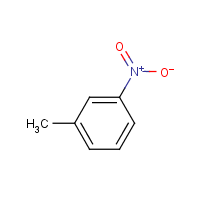m-Nitrotoluene
Agent Name
m-Nitrotoluene
Alternative Name
3-Nitrotoluene
CAS Number
99-08-1
Formula
C7-H7-N-O2
Major Category
Nitrogen Compounds

Synonyms
1-Methyl-3-nitrobenzene; 3-Methylnitrobenzene; 3-Nitrotoluene; 3-Nitrotoluol; Nitrotoluene, all isomers; Toluene, m-nitro-; m-Methylnitrobenzene; m-Nitrotoluene; m-Nitrotoluol; meta-Nitrotoluol; [ChemIDplus] UN1664
Category
Nitros, Aromatic
Description
Yellow liquid with a weak, aromatic odor. [Note: A solid below 59 degrees F.]; [NIOSH]
Sources/Uses
The meta isomer is not commercially significant; [ACGIH]
Comments
Nitrotoluenes (all isomers) have the potential to induce methemoglobinemia in the same manner as aniline and nitrobenzene. [ACGIH] Can induce methemoglobinemia; A mild skin and eye irritant; [ICSC]
Biomedical References
Exposure Assessment
BEI
Methemoglobin in blood = 1.5% of hemoglobin during or at end of shift. [ACGIH]
Skin Designation (ACGIH)
Yes
TLV (ACGIH)
2 ppm
PEL (OSHA)
5 ppm
IDLH (NIOSH)
200 ppm
Excerpts from Documentation for IDLHs
Basis for revised IDLH: Based on acute oral toxicity data in animals [Back et al. 1972; Vasilerko et al. 1978] and an analogy to nitrobenzene [Linch 1974] which has an IDLH of 200 ppm, the original IDLH for nitrotoluene (200 ppm) is not being revised at this time.
Vapor Pressure
0.1 mm Hg
Odor Threshold Low
0.05 ppm
Lethal Concentration
LC50 (rat) = 693 mg/m3
Explanatory Notes
Odor threshold from "Quick Guide: The Electronic NIOSH Pocket Guide to Chemical Hazards"; Flash point = 106 deg C; VP from HSDB;
NFPA
must be preheated
Adverse Effects
Methemoglobinemia
MetHgb is primary toxic effect
IARC Carcinogen
Not classifiable
Diseases, Processes, and Activities Linked to This Agent
Diseases
Occupational diseases associated with exposure to this agent: